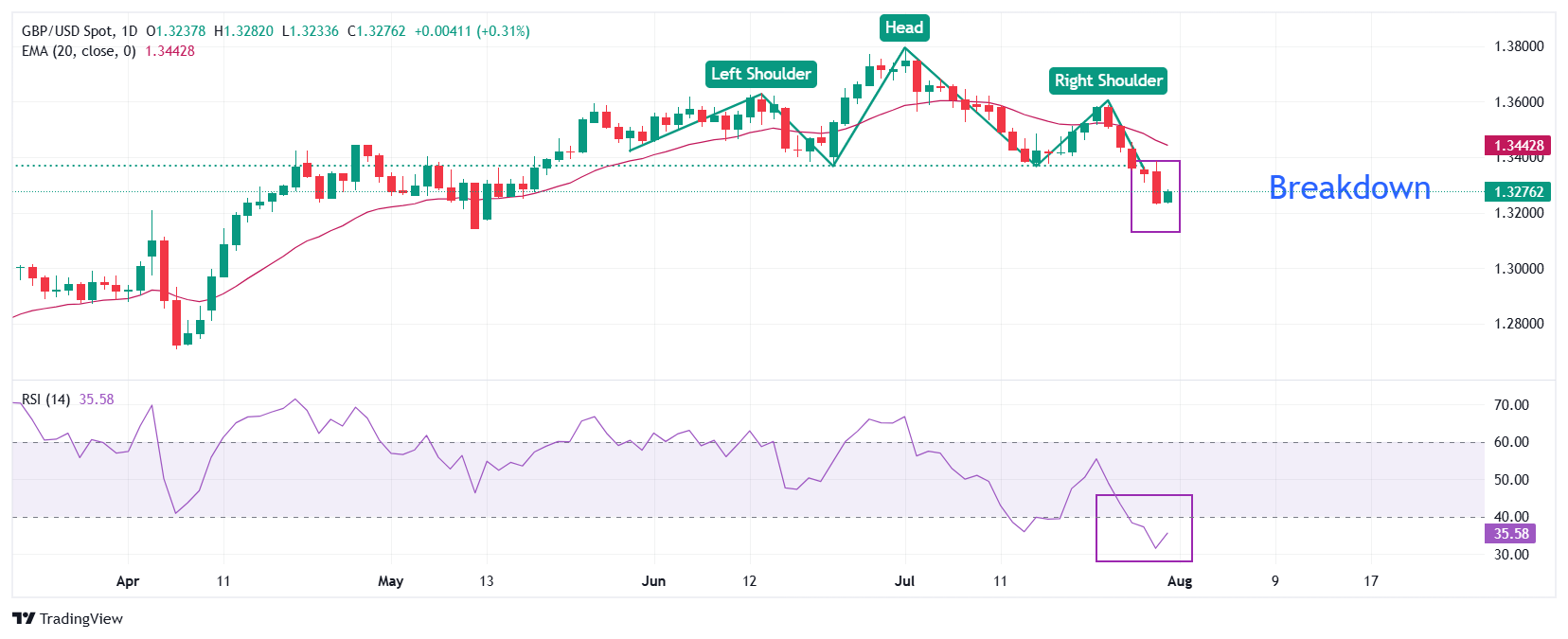Pound Sterling finds cushion as US Dollar takes a breather from recent rally
- The Pound Sterling attracts bids near 1.3230 against the US Dollar, struggling to extend its winning streak.
- Traders pare Fed interest-rate cut bets as Chairman Powell warns of upside inflation risks.
- Investors expect the BoE to cut interest rates next week.
The Pound Sterling (GBP) rebounds slightly to near 1.3270 against the US Dollar (USD) during the European trading session on Thursday, bouncing from an over two-month low of 1.3228 posted the previous day. The GBP/USD pair attracts bids as the US Dollar takes a breather after a five-day winning streak, but the broader outlook of. the Cable is bearish as the US Dollar remains broadly firm.
At the time of writing, the US Dollar Index (DXY), which tracks the Greenback’s value against six major currencies, corrects slightly to near 99.60 from the two-month high around 100.00 posted on Wednesday.
The Greenback attracted significant bids on Wednesday after upbeat US Gross Domestic Product (GDP) and employment data, as well as Federal Reserve (Fed) Chair Jerome Powell’s support for keeping interest rates at their current levels. These forced traders to pare bets supporting interest-rate cuts by the Fed in the September meeting, supporting the US Dollar.
According to the CME FedWatch tool, the probability for the Fed to cut interest rates in September has fallen to 43.2% from 63.3% seen on Tuesday.
Powell signaled that monetary policy adjustments are inappropriate as the economy is in a “solid position” and inflation is “somewhat above target”.
Daily digest market movers: Pound Sterling weakens against its peers
- The Pound Sterling underperforms against other major currencies, except North American peers, on Thursday. The British currency has traded broadly stable this week due to a light economic calendar in the United Kingdom (UK).
- Investors brace for significant volatility in the Pound Sterling ahead of the Bank of England’s (BoE) interest rate decision, which will be announced next week.
- Traders are increasingly confident that the BoE will reduce interest rates by 25 basis points (bps) to 4%.Still, the UK central bank might need to perform a delicate balancing act while discussing on interest rates amid escalating price pressures and cooling labor market conditions.
- The Latest economic indicators in the UK have signaled a slowdown in the hiring trend due to an increase in the employers’ contribution to social security schemes.
- Going forward, the GBP/USD pair will be influenced by the US Nonfarm Payrolls (NFP) and the ISM Manufacturing PMI data for July, which is scheduled to be released on Friday. Economists expect the US economy to have added 110K fresh workers in July, lower than the 147K jobs created in June. The ISM Manufacturing PMI is seen higher at 49.5 from 49.0 in June, suggesting that activity in the US factory sector continued to decline but at a modest pace.
- Washington has reached a trade agreement with one more of its key trading partners. On Wednesday, US President Trump announced a tariff deal with South Korea by which the US will charge 15% tariffs on Korean imports. The baseline tariff rate is lower than the 25% threatened by Trump at the start of the month.
Technical Analysis: Pound Sterling finds temporary support near 1.3230

The Pound Sterling finds cushion near a over two-month low at around 1.3230 against the US Dollar on Thursday. However, the outlook of the GBP/USD pair remains bearish as it has broken down below the neckline of a bearish Head and Shoulder (H&S) chart pattern. The neckline of the H&S formation is plotted around 1.3370.
The downward-sloping 20-day Exponential Moving Average (EMA), near 1.3442, suggests that the near-term trend is bearish.
The 14-day Relative Strength Index (RSI) oscillates well below 40.00, almost reaching oversold levels, indicating that a bearish momentum is intact.
Looking down, the May 12 low of 1.3140 will act as a key support zone. On the upside, the psychological level of 1.3500 will act as a key barrier.




